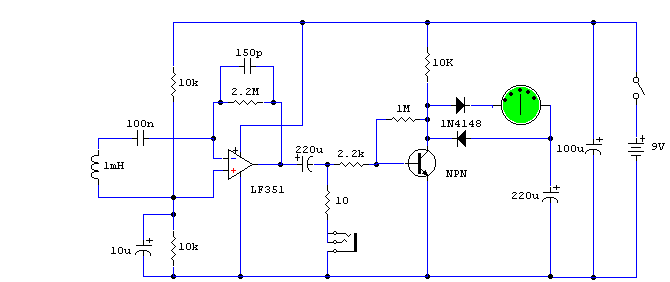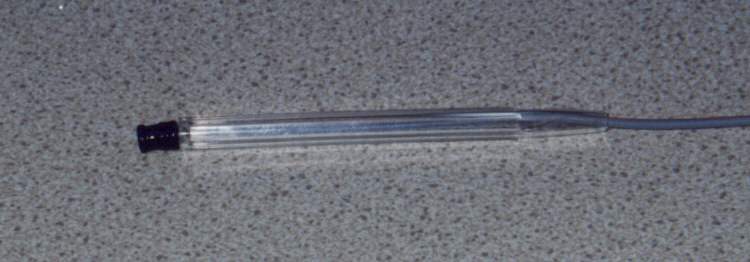

Notes:
This tester is designed to locate stray
electromagnetic (EM) fields. It will easily detect both audio and RF signals up
to frequencies of around 100kHz. Note, however that this circuit is NOT a metal
detector, but will detect metal wiring if it conducting ac current. Frequency
response is from 50Hz to about 100kHz gain being rolled off by the 150p
capacitor, the gain of the op-amp and input capacitance of the probe cable.
Stereo headphones may be used to monitor audio frequencies at the socket,
SK1.
Probe
Construction:
I used a radial type inductor with 50cm of screened
cable threaded through a pen tube. The cable may be used with a plug and socket
if desired. My probe is shown below:

A wrap of insulating tape or glue is used to secure the pen body to the inductor.
Meter
Circuit
The output at the op-amp will be an ac voltage, at
the frequency of the electro-magnetic field. This voltage is further amplified
by the BC109C transistor, before being full wave rectified and fed to the
meter. The meter is a small dc panel meter with a FSD of 250uA.
Rectification takes place via the diodes, meter and
capacitor.
Testing
If you have access to an audio signal generator you
can apply an audio signal to the windings of a small transformer. This will set
up an electromagnetic field which will be easily detected by the probe. Without
a signal generator, just place the probe near a power supply, mains wiring or
other electrical device. There will be a deflection on the meter and sound in
the headphones if the frequency is below 15KHz.
In
Use
I remember once building a high gain preamp (for
audio use). I made a power supply in the same enclosure. The preamp worked, but
suffered from an awful mains hum. This was not directly from ripple on the
power supply as it was regulated and well smoothed. What I had done was
built the audio circuit on a small piece of veroboard, and placed it within a
distance that was less than the diameter of the transformer. The transformers
own electromagnetic field was responsible for the induced noise and hum. I
should however note, that this was when I was new to electronics with very
little practical experience. You can now buy toroidal transformers which
have a much reduced hum field.
Return to Test Gear